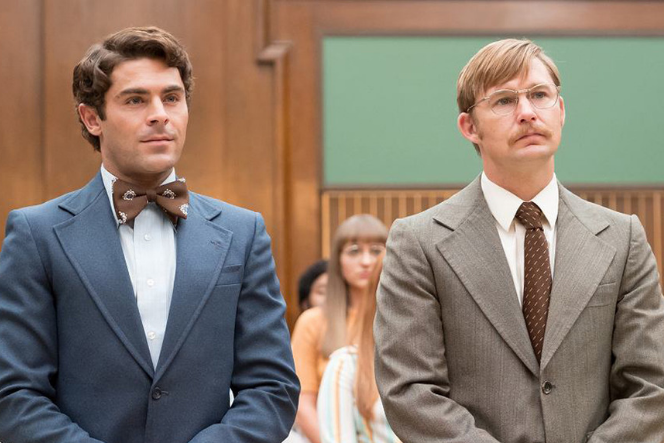Extremely Wicked, Shockingly Evil and Vile dropped on Netflix on May 3rd, starring Zac Efron as Ted Bundy. After the trailer dropped in January, there was some controversy over the possible glorification or romanticisation of Bundy – the trailer depicted an attractive, charismatic man who people loved rather than a stone-cold killer. I decided to check out the movie to make my own mind up about the portrayal.
If you don’t know already, Ted Bundy was an American serial killer who murdered more than 30 young women during the 1970s. He would approach women in public places acting as an authority figure or fake an injury to compel women to stay and chat. Bundy was regarded as charming; his charisma and good-looks allowed him to gain the trust of unsuspecting women. Bundy would then take them to a secondary location before assaulting and murdering them, often decapitating them and keeping their heads in his apartment. Sometimes, he would return to the secondary location and perform sexual acts on the decomposing bodies. People didn’t expect Bundy to be capable of these crimes – he was intelligent, funny, and confident. He volunteered for a suicide helpline, went to church, and was studying to become a lawyer – not what you assume a serial killer and necrophile to look like.

When the trailer for Extremely Wicked, Shockingly Evil and Vile was released earlier this year starring (the very handsome, very Disney) Zac Efron, there were mixed reactions. I understand why. When you hear the horrible things that Bundy did, you don’t expect such a God-awful person to be portrayed by someone you’ve grown up loving. The trailer also had upbeat music and a rom-com vibe, making the film seem like anything but the dark murder mystery that the title and subject had implied. It turns out the film is based on The Phantom Prince: My Life with Ted Bundy by Elizabeth Kendall – Bundy’s ex-girlfriend – and the film would, therefore, be from her perspective. Interesting.
The following contains spoilers for Extremely Wicked, Shockingly Evil and Vile – but do spoilers even count when the movie is based on a well-known serial killer from the ’70s?
The movie starts off with Elizabeth (Liz, played by Lily Collins) and Ted meeting for the first time – they danced together at a bar, he came back to her place, found out she had a child and still wanted to see her. He made her and her daughter breakfast the next morning and they continued to stay together for several years. We jump forward six years where Bundy is pulled over by a police officer. He is later put on trial for kidnapping and threatening to kill a woman. Despite pleading not guilty, he is found guilty of aggravated kidnapping and is sentenced to a minimum of one year, and a maximum of fifteen years in prison.
He is shortly moved to Colorado where he is charged for murder. He elects to be his own lawyer and is therefore free of any handcuffs. During a recess, Ted escapes through a window in the courthouse and flees up into the mountains but is captured six days later. Liz and Ted break up. Ted saws a hole in the ceiling of his cell and escapes through it. Two women are murdered, and two others are brutally attacked at a sorority house in Florida. Ted is then arrested again but he’s gained a following – young females who are obsessed with the case and are unsure that he’s guilty.

Ted contacts a friend, Carole Ann Boone (played by Kaya Scodelario), and a relationship forms as she vouches for his innocence. Liz confesses to her new boyfriend that she was the one who gave the police Ted’s name years ago. More trial scenes for other murders (including that of a twelve-year-old girl) ensue, where Ted is his own attorney, and he maintains his innocence throughout. Finally, he is convicted of three counts of attempted first-degree murder and two counts of burglary. He is sentenced to death by electrocution. Ten years later, Liz visits Ted in prison where he still maintains his innocence. Liz shows Ted an image of a decapitated body, demanding an explanation as to what happened to her. Ted fogs up the glass with his breath and writes “HACKSAW” with his finger. Ted was executed in January 1989, days after he confessed to 30 murders.
The facts within this film are mostly correct, slightly differing from Elizabeth Kendall’s book. In the film, the only hint of a red flag Liz received during their relationship was a dog barking at Ted – aside from that, Liz believed he was innocent until the end of the film. In reality, she read stories of a man thought to be named “Ted” who was involved in several murders in Washington state in 1974, one of which involved the suspect killing a victim with a crutch. Kendall recalls crutches in Bundy’s house, as well as other objects which were linked to other murders in the area. The sketch of the suspect also strongly resembled Bundy, so she gave his name to the police.
In the book, Bundy never admits the murders to Kendall – he hints at his guilt via a phone call, but he never actually says it. In the same call, however, Bundy admits to closing the damper at Kendall’s house and shoving a towel underneath the door so that smoke couldn’t escape from the chimney in an attempt to kill her.

While the film does a good job of showing that anyone can be a murderer, I feel that Bundy wasn’t held accountable for his actions. The escape scenes seem “fun” and high-paced, and it feels as though we are supposed to be supporting Ted through these things. Until the end of the film, we aren’t shown his actions. Though I understand that it is taken from Kendall’s perspective, it feels as though the film wants us to support him, to encourage him. Bundy’s real-life charisma is supposed to echo throughout the film, making us unsure of what is true and what is not, therefore allowing us to understand the mentality surrounding the case. It feels as though we are told to support the underdog, the rebel, the guy who was just in the wrong place at the wrong time. This movie fails to show us the brutal side of the crimes he committed, the women he assaulted, and the lives he ruined. It only shows the charismatic and “nice” attitude that he wanted the world to see.
It’s important to show that people are capable of anything, despite the face they put on for the public. However, this film chose to focus on the interesting side of a bad guy, rather than on the lives took or ruined. Ted Bundy was a murderer, a rapist, a burglar, a necrophile, a kidnapper, and a sociopath. He should be acknowledged as charming and compelling, though his actions should not be belittled for the sake of a mysterious “did he/didn’t he?” movie ending.

